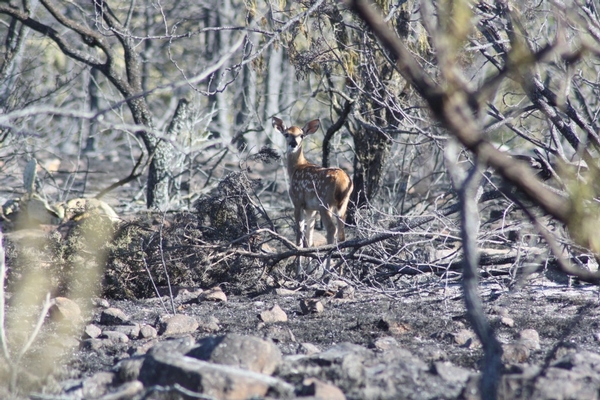
Prescribed Burning for Better Wildlife

Wildfire and prescribed fire are similar to illegal drugs and prescription drugs. The first can destroy your home and possibly kill you while the second will improve your wildlife habitat and cure your ailments. Wildfires and illegal drugs carry heavy negative impacts while prescribed fire and prescription drugs carry positive and healing impacts.
Popular throughout the last century, Smokey the Bear had a major influence on many young lives. His overall message was well-meaning but often misinterpreted. Children grew up fearing fire of any kind because Smokey said fire was bad. In wildfire conditions, he was correct, but under controlled conditions, fire can be the best tool used to help turn a property around– to increase the overall herbaceous production, to add weight gain to the animals, to rejuvenate new growth, to remove thick layers of thatch that prevent forbs/weeds and new grasses from growing, to even encouraging new plant species to grow and prosper. Prescribed fire is the answer to old, tired, rangeland that has become stale and stagnant and in need of a shot of production. Prescribed fire adds fertilizer—thru the combustion and restructuring of nutrients—back into the soil where it belongs and becomes usable again. Prescribed fire “opens up” the short herbaceous canopy, thins out invading brush and grass species, removes the young, old, and dead plants and improves sunlight, rain and nutrient penetration at ground level. Prescribed fire stimulates soil micro-organisms and begins the natural food chain from the earliest of stages and thereby creating a much more stable, vigorous and healthy habitat.
Prescribed burns generally occur during two times of the year–summer reclamation burns and fall cool season burns. A summer burn is considered a “hot” fire used to kill large trees (cedars, huisache, mesquite) primarily to reclaim overgrown pastures that need to be returned back into long-term production. A summer burn is very aggressive and destructive and extreme care must be used when using it. A winter burn is considered a “cool” fire and is used primarily to top-remove any debris, set back (not necessarily kill) invading brush species and encourage a quick regrowth response. The fire temperature is hot enough to do the job yet not so hot as to kill large trees or mature brush species — targeting primarily the short brush and grass canopies. Cool season burns are best used to generate browse plant regrowth and forb/weed production—forages that wildlife highly prefer.
Obvious safe-guards need to be in place before any burn: suitable fireguards around the perimeter of the area to be burned, a low humidity/low wind day with a favorable wind direction in order to direct the fire and smoke as desired, and ample experienced help on hand to assist. Heavy equipment such as water spray rigs, dozers, or a tractor and disc are always wise. A game plan for the actual burn and a backup plan should something go awry is also needed, not to mention contacting local neighbors, sheriff office and fire departments to let them know your intentions.
Burning is not for the weak of heart. It required much planning and coordination and weather forecasting, but the benefits of a successful burn outweight all the troubles and stress involved. A burned area is the first to green up and animals will walk great distances to feed on the new lush growth. Fire removes the thorns and needles found on aggressive plants, so many animals enter the burn area even before the smoke clears in order to feed on such delicacies.
Tame pastures, rangelands and even brushy pastures can benefit from prescribed fire. Use fire as a tool just as you do with heavy equipment, responsible cattle grazing and selective harvest. It is one of the cheapest and quickest forms of habitat management available today and it will make a believer out of you once you give it a chance.
All photo and content herein is copyrighted property of Spring Creek Outdoors, LLC and may not be copied/reproduced or otherwise used in any way without express written permission from Spring Creek Outdoors, LLC. All rights reserved.
Posted in: Land Management
